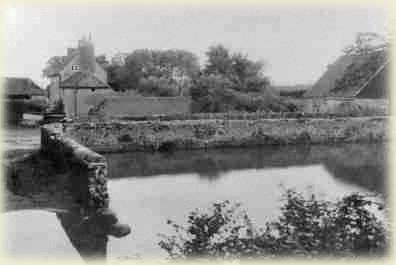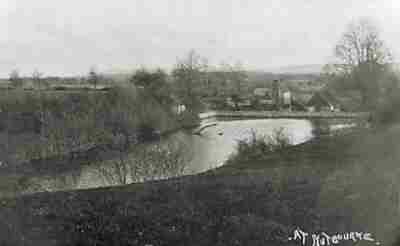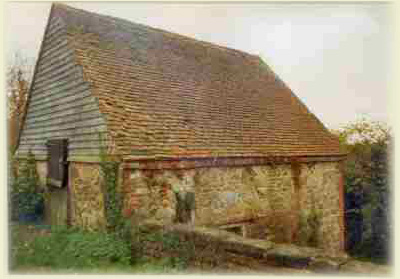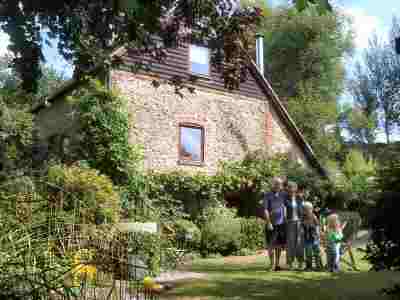Below, Patrick Uden tells the story of the restoration of The Wheel House
I have been told that the hamlet of Nutbourne once centred on the mill and it wasn't until the coming of train services from London to Pulborough that brick houses - including the expansion of Nutbourne Manor - started to be constructed in density along The Street.
This makes sense. Mill House, The Wheel House, The Old Manor House, and other cottages line up to create a rough east-west village, rather than the later north-south one (Presumably the track running west from the mill and curving right at The Old Manor to continue upwards north-west beside the sunken tree-lined walk towards the fields, is the old 'high street').
This change of orientation coincided with the slow decline of local bakeries from 1918 until the arrival of steam-ovened white sliced bread in the late 1940s. Legend has it that the miller and baker of Nutbourne, depressed at the prospects for his business and the price pressure on his bread sold from the ex-grain store at Mill House, killed himself by tying a millstone round his neck and jumping into the pond. Apparently the mill's overshoot wheel had been removed much earlier in 1939, turning the Mill House complex into a bakery only. Whatever the truth, by 1960 the mill was derelict and used as a rough storehouse for farm implements. It remained in this condition until the late 1970s.
The mill, now The Wheel House, first came to my attention as a sale card in an estate agent's window in Arundel. Called The Old Watermill, it was on sale at £150,000. The picture showed an apparently well constructed conversion with ham fisted 'cottage' details like 'stable doors' with fake bottle glass whirls in their windows. Horrible!
With little else to do on a wet and gloomy Sunday afternoon I drove back to London via Nutbourne to find it. It looked grim indeed. Abandoned cars, mud, condensation on the windows, a weed filled garden and lashing rain made it look undesirable indeed. Only its quirky position snuggled up against the dam wall had any charm. That was November 1989.
In April the following year I was in West Sussex again. I decided to have another look at The Old Watermill on my way back to London. This time it was a bright Spring Sunday. Daffodils and primroses carpeted the grass. Even the wrecked cars and scruffy garden seemed happier. The following Monday morning I telephoned the agent in Arundel. It was still for sale so I casually offered £140,000. They snapped at it.
A long and convoluted negotiation got underway revealing why no one had bought the little house. The chap selling had done the conversion himself, driving his neighbours, Sir Francis and Lady Avery Jones, almost apoplectic in the process.
He and his wife had started the conversion together, but now they had split up. The money had run out. His girlfriend now lived - or should that be camped? - in it, but with heating by inadequate wood-burning stove, bottled calor gas and gimcrack plumbing, life wasn't much fun.
The entire shambles was further complicated by a complete lack of paperwork on the vendor's side. After more than a year of frustrating stop-go talks I finally agreed to buy the place, pretty much on trust.
In 1992 I started work renovating it and, at Sir Francis Avery Jones' suggestion, renamed it 'The Wheel House' (Apparently the unofficial moniker it carried in the 19th Century). First the garden, then the flooring, then the doors, then the plumbing, then the heating - on and on it went until in 1994 I felt it was finished enough to be lived in.
I had spent high, everything top quality: hardwood doors, Portuguese terracotta floors, antique Victorian door furniture, Italian reproduction 'thirties bathroom fittings, a power-shower, cedarwood blinds, French cooker and kitchen taps, American kitchen sink, etc. I used brass screws throughout, no cross-heads and no steel screws except where the heads didn't show. All the shelves were made by me from reclaimed pub table pitch pine. The interior wall colours were taken from French and Italian house exteriors I had photographed and filed. I restored some antique light switches and retro-fitted these to the downstairs and first floor rooms. All materials were either natural, new-distressed or original.
A new wood burning stove was installed and bricked-in to the corner of the downstairs lounge. The bigger fire needed a wider steel chimney. This was done. Against all odds I managed to get gas run from the main, down the track, as far as Mill House. In the winter of 1993 central heating was installed and for the first time in its existence the house became warm and inviting.
All this time I was re-creating the small garden. I had new fencing made and finally rolled an old but unused mill stone, buried in the garden, up onto a plinth to use as a garden table. I had steel railings made for the mill race and the garden steps and front door steps. The latter were based on the design of the railings outside The Rising Sun pub.
The Wheel House turned out to be an idyllic spot. It is south facing on a south facing slope. The dam wall made a sun-trap that warmed up the entire garden, yet being low the earth remained damp and cool all summer. From 1995 until 1999 I improved the house and its garden every weekend.
|

 Upper Nash
Historic Houses
Upper Nash
Historic Houses
 Past Events in Pictures
Past Events in Pictures
 A history of The Common
A history of The Common



